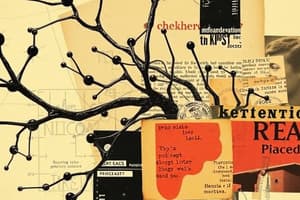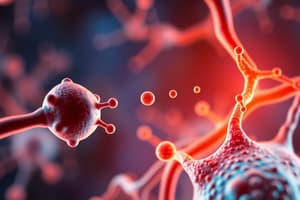Podcast
Questions and Answers
What is one key characteristic of ionotropic receptors compared to metabotropic receptors?
What is one key characteristic of ionotropic receptors compared to metabotropic receptors?
- They directly activate G proteins.
- They have a slower postsynaptic effect.
- They have a binding site and a membrane spanning domain that forms an ion channel. (correct)
- They only bind to serotonin neurotransmitters.
Which neurotransmitter is primarily involved in the learning and memory process?
Which neurotransmitter is primarily involved in the learning and memory process?
- Acetylcholine (correct)
- Norepinephrine
- Dopamine
- GABA
What is the primary function of dopamine in the brain?
What is the primary function of dopamine in the brain?
- Primarily used in the peripheral nervous system.
- Involved in reward processing. (correct)
- Synthesized from tryptophan.
- Involved in mood regulation only.
Which category of neurotransmitters does serotonin belong to?
Which category of neurotransmitters does serotonin belong to?
Which psychoactive drug is classified as a stimulant?
Which psychoactive drug is classified as a stimulant?
What is the primary function of dendrites in a neuron?
What is the primary function of dendrites in a neuron?
Which neurotransmitter's reuptake does ecstasy block?
Which neurotransmitter's reuptake does ecstasy block?
What role do astrocytes play in the brain?
What role do astrocytes play in the brain?
What is the main effect of alcohol on the GABAa receptor?
What is the main effect of alcohol on the GABAa receptor?
Which part of the neuron is primarily responsible for conducting electrical impulses away from the cell body?
Which part of the neuron is primarily responsible for conducting electrical impulses away from the cell body?
What is the primary change observed in dendritic spines in response to environmental stimuli?
What is the primary change observed in dendritic spines in response to environmental stimuli?
In neuron classification, what characteristic can be used to differentiate between types of neurons?
In neuron classification, what characteristic can be used to differentiate between types of neurons?
What are microtubules primarily responsible for within the cytoskeleton of a neuron?
What are microtubules primarily responsible for within the cytoskeleton of a neuron?
What primarily causes the depolarization phase of an action potential?
What primarily causes the depolarization phase of an action potential?
Which mechanism is NOT involved in the deactivation of neurotransmitters?
Which mechanism is NOT involved in the deactivation of neurotransmitters?
During hyperpolarization, what happens to the membrane potential?
During hyperpolarization, what happens to the membrane potential?
What is the main role of the blood-brain barrier (BBB)?
What is the main role of the blood-brain barrier (BBB)?
What is the primary function of the cerebellum?
What is the primary function of the cerebellum?
Which type of synapse provides simple communication by direct ion movement?
Which type of synapse provides simple communication by direct ion movement?
Which part of the brain is primarily responsible for auditory and visual processing?
Which part of the brain is primarily responsible for auditory and visual processing?
What happens during the absolute refractory period?
What happens during the absolute refractory period?
What is the main role of cerebrospinal fluid (CSF)?
What is the main role of cerebrospinal fluid (CSF)?
Which layer is NOT one of the meninges?
Which layer is NOT one of the meninges?
What is the result of excitatory postsynaptic potential (EPSP)?
What is the result of excitatory postsynaptic potential (EPSP)?
What are the main components of an action potential in terms of ion movement?
What are the main components of an action potential in terms of ion movement?
What does presynaptic facilitation refer to?
What does presynaptic facilitation refer to?
Flashcards are hidden until you start studying
Study Notes
Neurotransmitters
- Neurotransmitters communicate locally across synapses, synthesized by neurons.
- Released in response to action potentials (AP) and have measurable effects on postsynaptic cells.
- Can mimic effects of drugs; mechanisms exist for their removal.
Post-Synaptic Receptors
- Ionotropic Receptors: Ligand-gated ion channels with two domains; rapid postsynaptic effects.
- Metabotropic Receptors: G protein-coupled receptors that lack ion channels, slower acting, with two binding sites.
Categories of Neurotransmitters
- Acetylcholine: Involved in neuromuscular transmission; nicotinic and muscarinic receptors associated with the autonomic nervous system and CNS functions like learning and memory.
- Monoamines:
- Catecholamines:
- Dopamine (DA): Synthesized from tyrosine; metabotropic receptors, involved in reward mechanisms.
- Norepinephrine (NA): Also derived from tyrosine; involved in arousal and fight/flight responses with diffusion for receptor activation.
- Indolamines:
- Serotonin: Affects mood, sleep, and appetite; receptors include 5-HT-R.
- Melatonin: Regulates sleep cycles.
- Catecholamines:
- Amino Acids:
- Glutamate: Key for memory; activates AMPA and NMDA receptors, facilitating depolarization and synaptic transmission.
Types of Psychoactive Drugs
- Depressants: Alcohol, barbiturates, benzodiazepines; induce sedation and relaxation.
- Stimulants: Caffeine, nicotine, cocaine, amphetamines; increase alertness and energy.
- Psychedelics: Marijuana, LSD, psilocybin, PCP, ecstasy; alter perception and mood.
- Opiates: Morphine, codeine, endorphins; provide pain relief and euphoria.
Drug Mechanisms
- Alcohol: Agonist for GABAa receptors, causes neural inhibition and sedation; NMDA receptor antagonist, leading to memory loss.
- Ecstasy: Inhibits reuptake of serotonin, heightening mood but may cause long-term depression and anxiety.
Neuron Structure
- Soma (Cell Body): Contains nucleus, synthesizes neurotransmitters, integrates signals.
- Dendrites: Receive input from other neurons, conduct stimulation; dendritic spines allow for synaptic transmission.
- Axon: Transmits electrical impulses away from the cell body; ends in axon terminals for communication with other neurons.
- Cytoskeleton Components: Microtubules for transport, neurofilaments provide support, and microfilaments for reorganizing branches.
Glial Cells
- Astrocytes: Provide structural and nutritional support, control synapse isolation, and maintain extracellular environment.
Resting Potential
- Neuron is -70mV, indicating a more negative charge inside the membrane compared to the outside.
- Ion concentrations maintained by diffusion and ion channels/pumps.
Action Potential Phases
- Depolarization: Sodium ions enter through voltage-gated channels.
- Repolarization: Membrane potential returns to resting state.
- Hyperpolarization: Opening of chloride channels adds negative charge.
- Action potentials follow an all-or-nothing principle, reaching +40mV if the threshold is met.
Synapse Structure and Function
- Composed of presynaptic neuron, synaptic cleft, and postsynaptic neuron.
- Electrical Synapses: Direct ion movement, rapid signal transmission.
- Chemical Synapses: Involve neurotransmitter release following action potentials.
Deactivation of Neurotransmitters
- Diffusion: Moves neurotransmitters from high to low concentration.
- Degradation: Enzymes break down neurotransmitters into inactive substances.
- Reuptake: Neurotransmitters re-enter presynaptic neuron.
Excitatory and Inhibitory Postsynaptic Potentials (EPSP/IPSP)
- EPSP: Positive ion influx causes depolarization, moving potential closer to threshold.
- IPSP: Negative ion influx results in hyperpolarization, moving potential away from threshold.
Neuromodulation
- Presynaptic Facilitation: Increased neurotransmitter release due to presynaptic input.
- Presynaptic Inhibition: Decreased neurotransmitter release from altered presynaptic influence.
Basic Anatomy of the Central Nervous System (CNS)
- Meninges: Comprises three protective layers—dura mater, arachnoid, pia mater.
- Cerebrospinal Fluid (CSF): Clear fluid providing protection, waste clearance, and intracranial pressure maintenance.
- Blood Supply: Supplied by vertebral and carotid arteries; blood-brain barrier is semipermeable to protect brain functions.
Central Nervous System Structures
- Spinal Cord: Segmented into cervical, thoracic, lumbar, sacral, and coccygeal regions.
- Brain Structures:
- Hindbrain:
- Medulla: Connects brain to spinal cord.
- Pons: Relays information from cortex to cerebellum.
- Cerebellum: Coordinate voluntary movements.
- Midbrain:
- Tectum: Involves auditory and visual processing.
- Tegmentum: Homeostatic and reflexive pathways.
- Forebrain:
- Diencephalon: Thalamus (sensory center), hypothalamus (regulatory functions).
- Telencephalon: Cortex (higher cognitive functions) and basal ganglia (movement planning).
- Hindbrain:
Studying That Suits You
Use AI to generate personalized quizzes and flashcards to suit your learning preferences.




